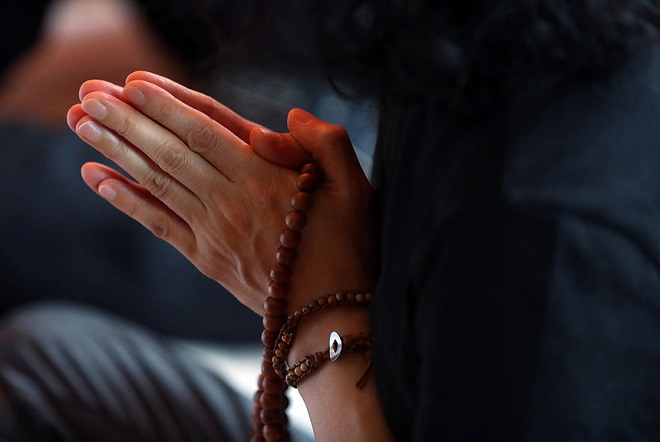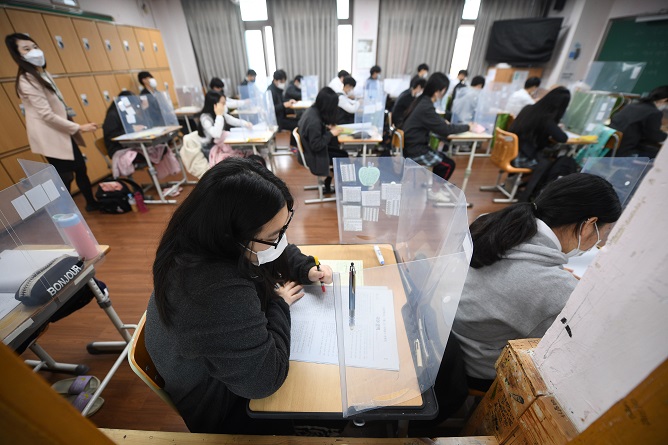SEOUL, Nov. 18 (Korea Bizwire) — A recent surge in coronavirus cases has increased anxiety about whether the national college entrance exam, the biggest academic event of the year, can be held safely in South Korea next month.
Education authorities are on high alert ahead of the Dec. 3 event, having postponed the exam, originally slated for Nov. 19, in late March, when the country was hit by the first wave of the pandemic.
They will launch a two-week special precautionary period starting Thursday, preparing for the test to be taken by hundreds of thousands of students and others.
“We can’t let our guard down even the slightest bit,” Education Minister Yoo Eun-hae said during a meeting with educational superintendents from around the country Wednesday, asking the ministry and education offices to prepare for the worsening of the pandemic.
“So far, the ministry has prepared separate testing places that can serve up to 120 patients and 3,800 students in self-isolation,” she said, “Given the recent spread of COVID-19, however, the number of those in self-isolation could grow.”
The government on Tuesday raised the virus alert level by one notch to Level 1.5, effective Thursday, in the capital area, amid a resurgence of COVID-19.
The measure is partly to “create a safe testing environment for students,” said Park Neunghoo, vice head 1 of the central countermeasure headquarters, when announcing the decision.
Under the new measure, the operation of multiuse and high-risk facilities will be restricted, and the attendance cap in schools is placed at two-thirds of the total student body.
The College Scholastic Ability Test (CSAT) is the country’s most important annual academic event, and the whole country almost grinds to a halt for the smooth administration of the test.
Public institutions and the stock markets open an hour late to reduce traffic congestion so that students arrive at testing sites on time.
Parents of test-takers said they have been cautious and taking strict social distancing measures.
A parent from South Chungcheong Province told Yonhap News Agency, “I am making trips only between my workplace and home to minimize chances of infection. I’ve stopped meeting up with colleagues and friends for after-hour drinks all together.”
Another parent from Geoje, South Gyeongsang Province, recently created a quiet study area at home.
“We’ve been very careful not to get infected with COVID-19 by driving her to school and having her study at no other place but home,” the parent said.

A mother prays for their children’s success in the College Scholastic Ability Test (CSAT) at a temple in Seoul. (Yonhap)
On Sunday, the Ministry of Education said it will closely monitor whether cram schools and study facilities thoroughly follow health protocols.
Also, cram schools are strongly advised against running in-person classes starting Nov. 26, and the names of schools will be made public in the case of an outbreak.
Last month, the ministry unveiled detailed guidelines to safely administer the CSAT for around 490,000 students.
Testing sites, 1,185 in total, will be set up in accordance with quarantine protocols, with a maximum capacity of 24 students per testing room, down from the usual 28, to ensure social distancing.
Spaced out desks will be installed with plastic dividers. Face masks will be mandatory, and there will be fever checks.
Students infected with the virus are allowed to take the test in hospitals or other government institutes. Those in self-quarantine should travel by car or ambulance to take the exam at separate testing sites.
There will be separate testing rooms for students who show COVID-19 symptoms on the testing day.
Those rooms can house up to four students, but if the room is spacious enough to ensure students can sit two meters apart, more than four can use the same room.
The ministry also said the exam papers of COVID-19 patients, as well as those in self-isolation or showing symptoms, will be disinfected to prevent possible transmission.
From a week before the test, all high schools and other schools to be used as testing sites will switch to online-only teaching for the disinfecting process.
Since Nov. 8, more than 100 daily new infections have been reported. On Wednesday, the tally hit 313, the highest number since Aug. 29, when the country logged 323 new cases.
With the absence of a single, large source of infection, new cases have been spotted at multiple locations and occasions throughout the country, making it harder for health authorities to implement their trace-and-isolate program to effectively slow down the spread.
(Yonhap)







